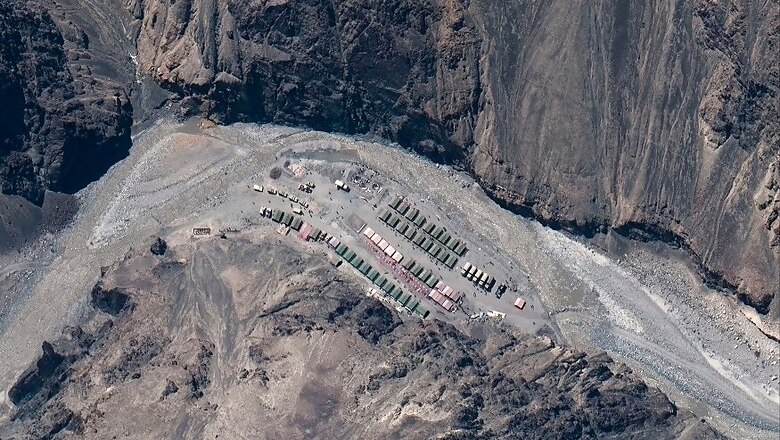
views
Lieutenant General Harinder Singh, the commander of India’s Leh-based XIV corps, and his People’s Liberation Army counterpart, South Xinjiang military region chief Major-General Liu Lin, have agreed on broad parameters to disengage troops in some contested zones along the Line of Actual Control in Ladakh, government sources familiar with the negotiations have told News18.
The two commanders met on Tuesday at the frontier outpost of Chushul, for talks that ran twelve hours. This was the third in a series of meetings so far. Neither New Delhi nor Beijing have issued any official communiqué or comment on the negotiations.
Parameters, the sources said, have now been agreed to disengage troops at Patrolling Point 14, 15 and 17, running from the Galwan Valley to the Hot Springs area, involving the PLA pulling back some hundreds of metres from territories claimed by India.
Government sources, however, said there had been little progress on ending the confrontation along the Pangong lake, the site of the largest build-up on the LAC, the source of a violent clash on May 5 that left soldiers on both sides severely injured.
“PLA commanders have shown no flexibility on Pangong so far,” an official said. “I think the reality is we’ll see piece-by-piece progress over a period of time… not the kind of one-shot settlement some might be hoping for,” the official added.
In meetings held on June 22, highly-placed government sources said the PLA had shown in-principle willingness to step back from its positions at Point 14, in the Galwan Valley, the site where a large-scale hand-to-hand battle between troops had led to the loss of the lives of 20 Indian Army soldiers.
PLA commanders, the sources said, had said they were also willing to move back from Point 15 and Point 17—in the Hot Springs and Gogra areas—where Chinese troops have intruded several hundred metres beyond what India asserts is the Line of Actual Control.
Patrolling Points—numbered sequentially on a north-south axis, with 1 at the Karakoram Pass—mark routes along which Indian troops demonstrate their physical presence on the China-India frontier, though the LAC in some cases lies well to its east. Point 16, in between Galwan and the Hot Springs area, lies well inside Indian territory, and is not contested.
The details and timing of the disengagement process, the sources said, were discussed in granular detail on Tuesday, along with measures to prevent tensions between troops from escalating into violence.
Both militaries hope to avoid what some experts have described as a Siachen-isation of the LAC, a reference to the India-Pakistan conflict of the Siachen Glacier, where troops remain continuously deployed in extreme weather conditions, and fire-exchanges often claim lives.
Negotiations, however, have remained deadlocked on the face-off along a series of eight ridge-lines radiating away from Pangong lake, known as Fingers, where the PLA has blocked Indian troops from patrolling up to their claimed LAC.
Though Indian troops traditionally patrolled forward from posts at Finger 3 to Finger 8, the PLA has built up earthworks and trenches to block their route. PLA troops now control the ridge-line of Finger 4, with Indian troops facing them from the ridge-line at Finger 3, and both sides are reported to have significantly built up troop numbers.
Government sources declined to comment on reports that the disengagement proposals involve the creation of informal demilitarised zones, where neither side would patrols beyond agreed held positions.
“Even though we should be cautious on the final outcome”, a government official familiar with the negotiations said, “there’s some reason for guarded optimism, at least in the particular areas the PLA is showing some flexibility”.
The negotiations, a senior Indo-Tibetan Border Police official said, will also leave unresolved a host of less-stark, but tactically significant, confrontations along the LAC. Ever since 2013, China has brought increasing pressure to bear on the LAC, even as an Indian programme for military logistical infrastructure in the region has accelerated.
For at least two years, intelligence sources say, Chinese troops have sought to block Indian patrols headed out from the key military outpost at Burtsé, near the Depsang plains, to Points 10, 11, 11A, 12 and 13—a patrol route that asserts India’s claim to hundreds of square kilometres of claimed territory east of the military outpost at Burtsé.
Bottleneck—the mountain defile through which patrol routes must pass to head east of Burtsé—is connected to PLA forward positions by road, while geography makes the construction of similar infrastructure on the Indian side difficult.
“Even though the PLA is not holding territory at Bottleneck, and is merely using patrols to block ours, the intent is clearly to undermine India’s claims to a large swathe of the LAC,” an intelligence official who has served in the area said.
To the south, PLA patrols have also been obstructing Indian patrols headed out of Demchok to the high-altitude Charding La pass—again using their superior road network to deploy blocking patrols. Indian Army soldiers were forced, a military source said, to use an alternative route that involved several days hiking through the mountains.
“The territory involved in Charding-La is trivial,” another official said, “but there does seem to be a pattern to the PLA’s behaviour”.
New reports have pointed to similar PLA intrusions in the eastern sector. Tapir Gao, the Bharatiya Janata Party’s Member of Parliament for the Arunachal East constituency, told News18 earlier this month that the PLA has stretches of territory in the Longju and Asapali sectors. Gao had made similar claims in 2019, which were denied by the Indian Army.



















Comments
0 comment